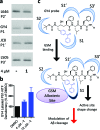Piperidine acetic acid based γ-secretase modulators directly bind to Presenilin-1
- PMID: 22229075
- PMCID: PMC3249837
- DOI: 10.1021/cn200098p
Piperidine acetic acid based γ-secretase modulators directly bind to Presenilin-1
Abstract
Aβ42 is believed to play a causative role in Alzheimer's disease (AD) pathogenesis. γ-Secretase modulators (GSMs) are actively being pursued as potential AD therapeutics because they selectively alter the cleavage site of the amyloid precursor protein (APP) to reduce the formation of Aβ42. However, the binding partner of acid based GSMs was unresolved until now. We have developed clickable photoaffinity probes based on piperidine acetic acid GSM-1 and identified PS1 as the target within the γ-secretase complex. Furthermore, we provide evidence that allosteric interaction of GSMs with PS1 results in a conformational change in the active site of the γ-secretase complex leading to the observed modulation of γ-secretase activity.
Figures




References
Grants and funding
LinkOut - more resources
Full Text Sources
Other Literature Sources

